Comparison of the Energy Consumption and Exhaust Emissions between Hybrid and Conventional Vehicles, as Well as Electric Vehicles Fitted with a Range Extender
Abstract
1. Introduction
2. Materials and Methods
2.1. The Test Route
- (a)
- The test route should be composed of three portions:
- The urban portion: distance min. 16 km, maximum vehicle speed 60 km/h, duration 29–44% of the entire test time with a tolerance of 10%;
- The rural portion: maximum vehicle speed 60–90 km/h, distance min. 16 km, duration 23–43% of the entire test time with a tolerance of 10%;
- The highway portion: vehicle speed in excess of 90 km/h, distance min. 16 km, duration 23–43% of the entire test time with a tolerance of 10%;
- (b)
- The share of the stationary vehicles on the urban portion should fall in the range of 6–30%;
- (c)
- On the highway portion, it is expected that the vehicle will drive with a speed of at least 100 km/h for a minimum of 5 min;
- (d)
- The maximum speed of the vehicle should not exceed 145 km/h (higher speeds are admitted but their shares cannot exceed 3% of the test);
- (e)
- The entire test should last from 90 to 120 min;
- (f)
- The test should start with the urban portion, and then the rural and highway portions should follow (small deviations from this order are allowed);
- (g)
- The relative road gradient between the start and end points should not exceed 100 m;
- (h)
- The vehicle should be driven by a single driver on all test route portions;
- (i)
- Pauses and unnecessary stops are not allowed during the tests.
2.2. Measurement Equipment
- (a)
- Concentrations of CO2, CO, NOx, THC and O2;
- (b)
- Mass exhaust gas flow, its temperature and pressure;
- (c)
- Temperature, pressure and humidity of the ambient air;
- (d)
- Vehicle GPS speed and position;
- (e)
- Basic engine operating parameters pulled from the vehicle OBD system.
2.3. Research Objects
3. Results
4. Conclusions
Author Contributions
Funding
Data Availability Statement
Conflicts of Interest
References
- Dora, C.; Phillips, M.A.; Phillips, M. Transport, Environment and Health; World Health Organization, Regional Office for Europe: Copenhagen, Denmark, 2000. [Google Scholar]
- EEA. Available online: https://www.eea.com (accessed on 25 January 2023).
- EPA. Tailpipe Greenhouse Gas Emissions from a Typical Passenger Vehicle. Available online: https://www.epa.gov/greenvehicles/greenhouse-gas-emissions-typical-passenger-vehicle (accessed on 25 January 2023).
- European Commision. Road Transport: Reducing CO2 Emissions from Vehicles. Available online: https://climate.ec.europa.eu/eu-action/transport-emissions/road-transport-reducing-co2-emissions-vehicles_en (accessed on 25 January 2023).
- Merkisz, J.; Pielecha, I. Alternatywne Źródła Napędowe; Wydawnistwo Politechniki Poznańskiej: Poznań, Poland, 2006. [Google Scholar]
- European Automobile Manufacturers Association. Vehicles in Use Europe 2022; European Automobile Manufacturers Association: Brussels, Belgium, 2022. [Google Scholar]
- IEA. Electric Vehicles. Available online: https://www.iea.org/reports/electric-vehicles (accessed on 25 January 2023).
- Toumasatos, Z.; Raptopoulos-Chatzistefanou, A.; Kolokotronis, D.; Pistikopoulos, P.; Samaras, Z.; Ntziachristos, L. The role of the driving dynamics beyond RDE limits and DPF regeneration events on pollutant emissions of a Euro 6d-temp passenger vehicle. J. Aerosol Sci. 2022, 161, 105947. [Google Scholar] [CrossRef]
- Varella, R.A.; Giechaskiel, B.; Sousa, L.; Duarte, G. Comparison of Portable Emissions Measurement Systems (PEMS) with Laboratory Grade Equipment. Appl. Sci. 2018, 8, 1633. [Google Scholar] [CrossRef]
- Pielecha, J.; Merkisz, J. Selected remarks about real driving emissions tests. Autobusy Tech. Eksploat. Syst. Transp. 2016, 17, 12. [Google Scholar]
- Andersson, J.; Maj, J.; Favre, C.; Bosteels, D.; de Vries, S.; Heaney, M.; Keenan, M.; Mansell, J. Oceny emisji na hamowni drogowej i podwoziowej z dwóch pojazdów z silnikiem Diesla spełniających normę Euro 6. SAE Int. J. Paliwa Lubr. 2014, 7, 919–934. [Google Scholar] [CrossRef]
- Merkisz, J.; Pielecha, J.; Bielaczyc, P.; Woodburn, J. Analiza Wskaźników Emisji w Badaniach RDE oraz NEDC i WLTC na Hamowni Podwoziowej; SAE Technical Paper; SAE: Warrendale, PA, USA, 2016. [Google Scholar]
- Fuć, P.; Kurc, B.; Siedlecki, M. Analysis of the Possibilities of Reduction of Exhaust Emissions from a Farm Tractor by Retrofitting Exhaust Aftertreatment. Energies 2022, 14, 7963. [Google Scholar]
- Lijewski, P.; Merkisz, J.; Fuć, P.; Ziółkowski, A.; Rymaniak, Ł.; Kusiak, W. Fuel consumption and exhaust emissions in the process of mechanized timber extraction and transport. Eur. J. For. Res. 2017, 136, 153–160. [Google Scholar] [CrossRef]
- Cubito, C.; Millo, F.; Boccardo, G.; Di Pierro, G.; Ciuffo, B.; Fontaras, G.; Serra, S.; Otura Garcia, M.; Trentadue, G. Impact of Different Driving Cycles and Operating Conditions on CO2 Emissions and Energy Management Strategies of a Euro-6 Hybrid Electric Vehicle. Energies 2017, 10, 1590. [Google Scholar] [CrossRef]
- Umut Karaoğlan, M.; Sefa Kuralay, N.; Ozgur Colpan, C. The effect of gear ratios on the exhaust emissions and fuel consumption of a parallel hybrid vehicle powertrain. J. Clean. Prod. 2019, 210, 1033–1041. [Google Scholar] [CrossRef]
- Frey, H.C.; Zheng, X.; Hu, J. Variability in Measured Real-World Operational Energy Use and Emission Rates of a Plug-In Hybrid Electric Vehicle. Energies 2020, 13, 1140. [Google Scholar] [CrossRef]
- Choi, Y.; Yi, H.; Oh, Y.; Park, S. Effects of engine restart strategy on particle number emissions from a hybrid electric vehicle equipped with a gasoline direct injection engine. Atmos. Environ. 2021, 253, 118359. [Google Scholar] [CrossRef]
- Fan, Q.; Wang, Y.; Xiao, J.; Wang, Z.; Li, W.; Jia, T.; Zheng, B.; Taylor, R. Effect of Oil Viscosity and Driving Mode on Oil Dilution and Transient Emissions including Particle Number in Plug-In Hybrid Electric Vehicle; SAE Technical Paper No. 2020-01-0362; SAE: Warrendale, PA, USA, 2020. [Google Scholar]
- Liu, Z.; Ivanco, A.; Filipi, Z.S. Impacts of Real-World Driving and Driver Aggressiveness on Fuel Consumption of 48V Mild Hybrid Vehicle. SAE Int. J. Altern. Powertrains 2016, 5, 249–258. [Google Scholar] [CrossRef]
- Pitanuwat, S.; Sripakagorn, A. An Investigation of Fuel Economy Potential of Hybrid Vehicles under Real-World Driving Conditions in Bangkok. Energy Procedia 2015, 79, 1046–1053. [Google Scholar] [CrossRef]
- Selleri, T.; Melas, A.D.; Franzetti, J.; Ferrarese, C.; Giechaskiel, B.; Suarez-Bertoa, R. On-Road and Laboratory Emissions from Three Gasoline Plug-In Hybrid Vehicles—Part 1: Regulated and Unregulated Gaseous Pollutants and Greenhouse Gases. Energies 2022, 15, 2401. [Google Scholar] [CrossRef]
- Melas, A.; Selleri, T.; Franzetti, J.; Ferrarese, C.; Suarez-Bertoa, R.; Giechaskiel, B. On-Road and Laboratory Emissions from Three Gasoline Plug-In Hybrid Vehicles—Part 2: Solid Particle Number Emissions. Energies 2022, 15, 5266. [Google Scholar] [CrossRef]
- Du, B.; Zhang, L.; Geng, Y.; Zhang, Y.; Xu, H.; Xiang, G. Testing and evaluation of cold-start emissions in a real driving emissions test. Transp. Res. D Transp. Environ. 2020, 86, 102447. [Google Scholar] [CrossRef]
- Suarez-Bertoa, R.; Valverde, V.; Pavlovic, J.; Clairotte, M.; Selli, T.; Franco, V.; Kregar, Z.; Astorga, C. On-road emissions of Euro 6d-TEMP passenger cars on Alpine routes during the winter period. Environ. Sci. Atmos. 2021, 1, 125–139. [Google Scholar] [CrossRef]
- Alvarez, R.; Weilenmann, M. Effect of low ambient temperature on fuel consumption and pollutants and CO2 emissions of hybrid electric vehicles in real-world conditions. Fuel 2012, 97, 119–124. [Google Scholar] [CrossRef]
- Feinauer, M.; Ehrenberger, S.; Epple, F.; Schripp, T.; Grein, T. Investigating Particulate and Nitrogen Oxides Emissions of a Plug-In Hybrid Electric Vehicle for a Real-World Driving Scenario. Appl. Sci. 2022, 12, 1404. [Google Scholar] [CrossRef]
- Prati, M.V.; Costagliola, M.A.; Giuzio, R.; Corsetti, C.; Beatrice, C. Emissions and energy consumption of a plug-in hybrid passenger car in Real Driving Emission (RDE) test. Transp. Eng. 2021, 4, 100069. [Google Scholar] [CrossRef]
- Wang, Y.; Wen, Y.; Zhu, Q.; Luo, J.; Yang, Z.; Su, S.; Wang, X.; Hao, L.; Tan, J.; Yin, H.; et al. Real driving energy consumption and CO2 & pollutant emission characteristics of a parallel plug-in hybrid electric vehicle under different propulsion modes. Energy 2022, 244, 123076. [Google Scholar]
- Mamala, J.; Śmieja, M.; Prażnowski, K. Analysis of the Total Unit Energy Consumption of a Car with a Hybrid Drive System in Real Operating Conditions. Energies 2021, 14, 3966. [Google Scholar] [CrossRef]
- Pielecha, J.; Skobiej, K.; Kurtyka, K. Exhaust Emissions and Energy Consumption Analysis of Conventional, Hybrid and Electric Vehicles in Real Driving Cycles. Energies 2020, 13, 6423. [Google Scholar] [CrossRef]
- Huang, R.; Ni, J.; Zheng, T.; Wang, Q.; Shi, X.; Cheng, Z. Characterizing and assessing the fuel economy, particle number and gaseous emissions performance of hybrid electric and conventional vehicles under different driving modes. Atmos. Pollut. Res. 2022, 13, 101597. [Google Scholar] [CrossRef]
- Rogemond, E.; Essayem, N.; Frety, R.; Perrichon, V.; Primet, M.; Mathis, F. Characterization of Model Three-Way Catalysts. J. Catal. 1997, 166, 229–235. [Google Scholar] [CrossRef]
- He, L.; You, Y.; Zheng, X.; Zhang, S.; Li, Z.; Zhang, Z.; Wu, Y.; Hao, J. The impacts from cold start and road grade on real-world emissions and fuel consumption of gasoline, diesel and hybrid-electric light-duty passenger vehicles. Sci. Total Environ. 2022, 851, 158045. [Google Scholar] [CrossRef]
- Huang, Y.; Surawski, N.C.; Organ, B.; Zhou, J.L.; Tang, O.H.; Chan, E.F. Fuel consumption and emissions performance under real driving: Comparison between hybrid and conventional vehicles. Sci. Total Environ. 2019, 659, 275–282. [Google Scholar] [CrossRef]
- Li, C.; Sato, S.; Ma, T.; Johnson, K.C.; Durbin, T.; Karavalakis, G. Real-Word Evaluation of Pollutant Emissions from a Light-Duty DI-Gasoline Hybrid Electric Vehicle (HEV) Using PEMS. Emiss. Control Sci. Technol. 2023, 9, 1–11. [Google Scholar] [CrossRef]
- Ziolkowski, A.; Daszkiewicz, P.; Rymaniak, Ł.; Fuć, P.; Ukleja, P. Analysis of the exhaust emissions from a hybrid vehicle during RDE tests. MATEC Web Conf. 2019, 294, 02002. [Google Scholar] [CrossRef]
- Bielaczyc, P.; Merkisz, J.; Pielecha, J.; Woodburn, J. A Comparison of Gaseous Emissions from a Hybrid Vehicle and a Non-Hybrid Vehicle under Real Driving Conditions; SAE Technical Paper 2018-01-1272; SAE International: Warrendale, PA, USA, 2018. [Google Scholar] [CrossRef]

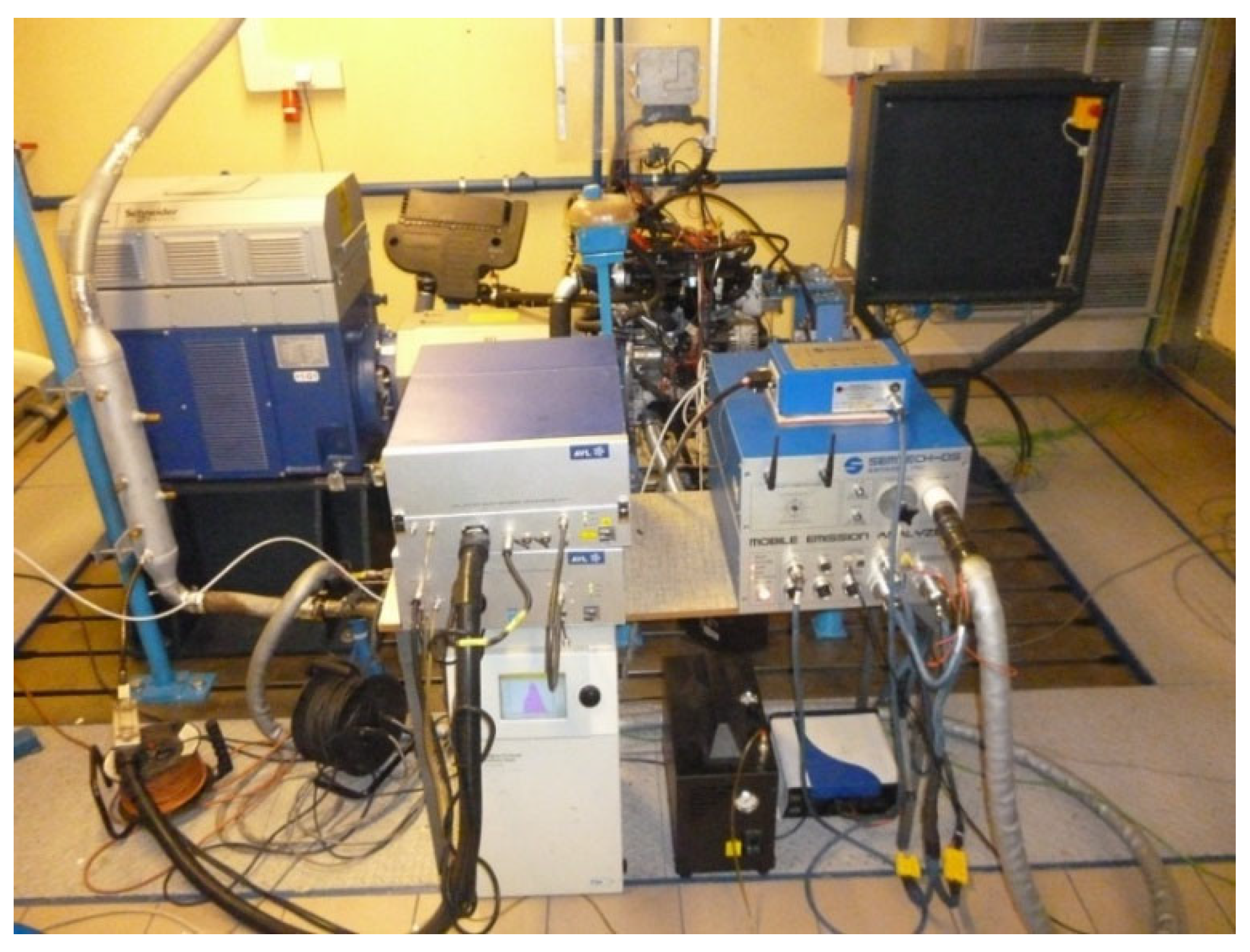




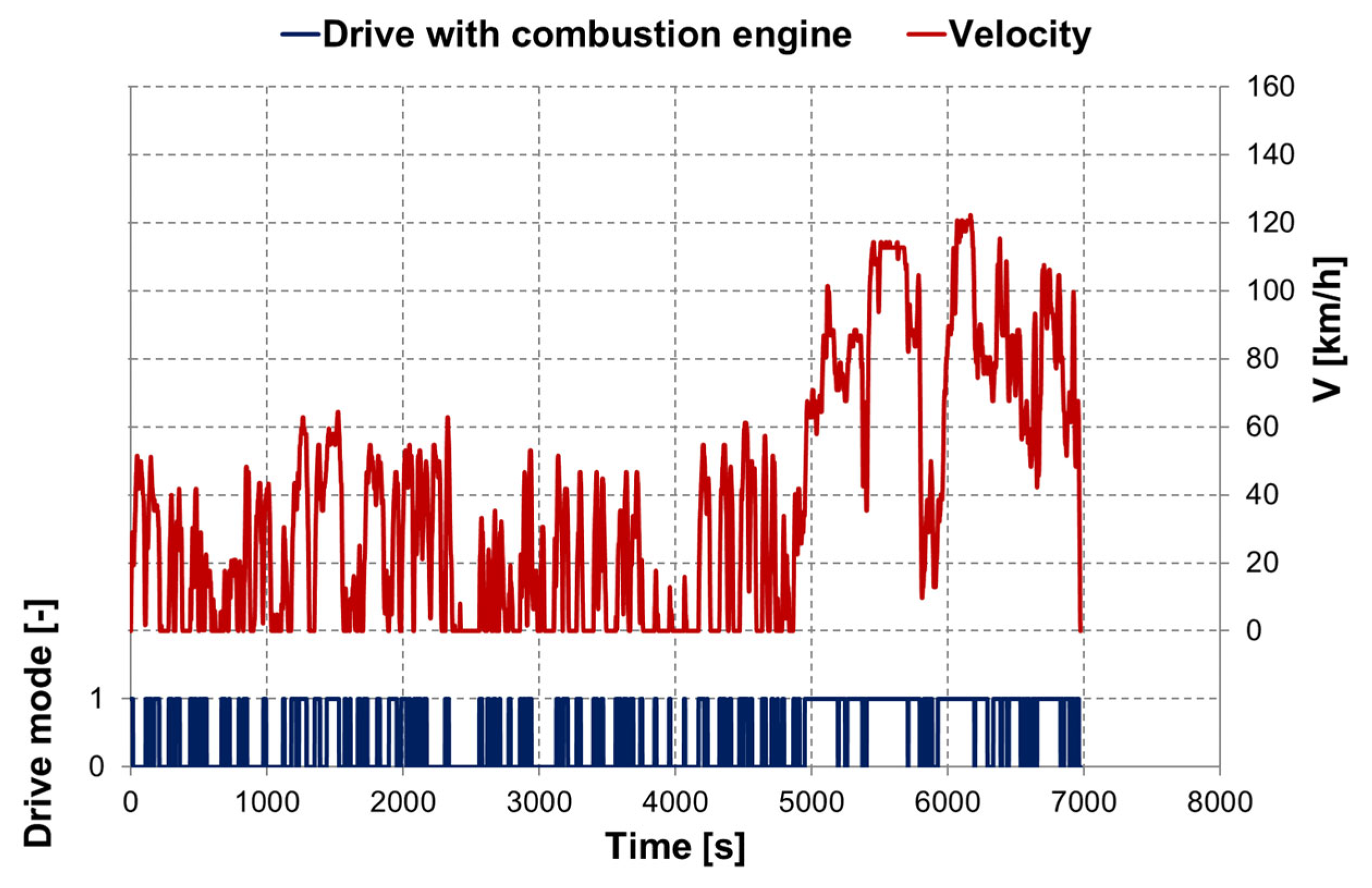

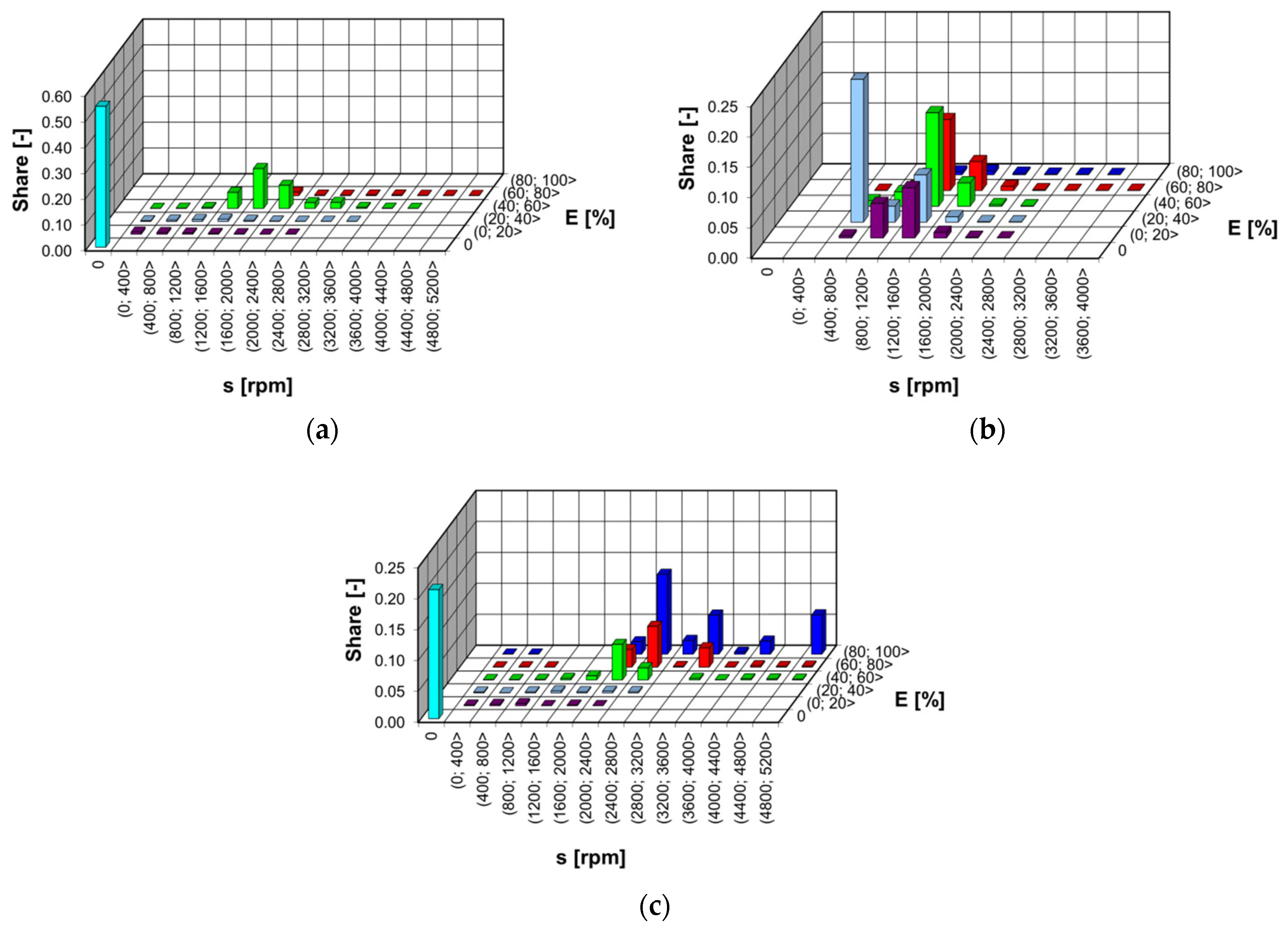

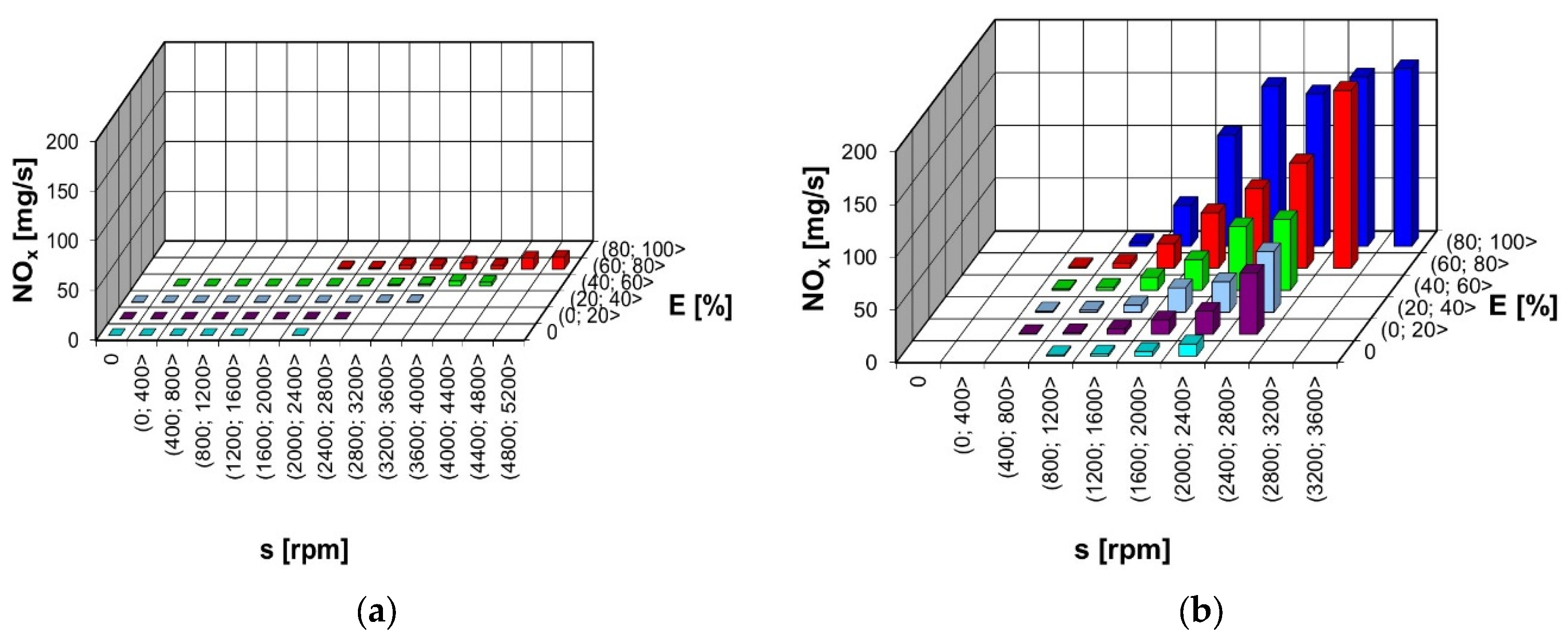


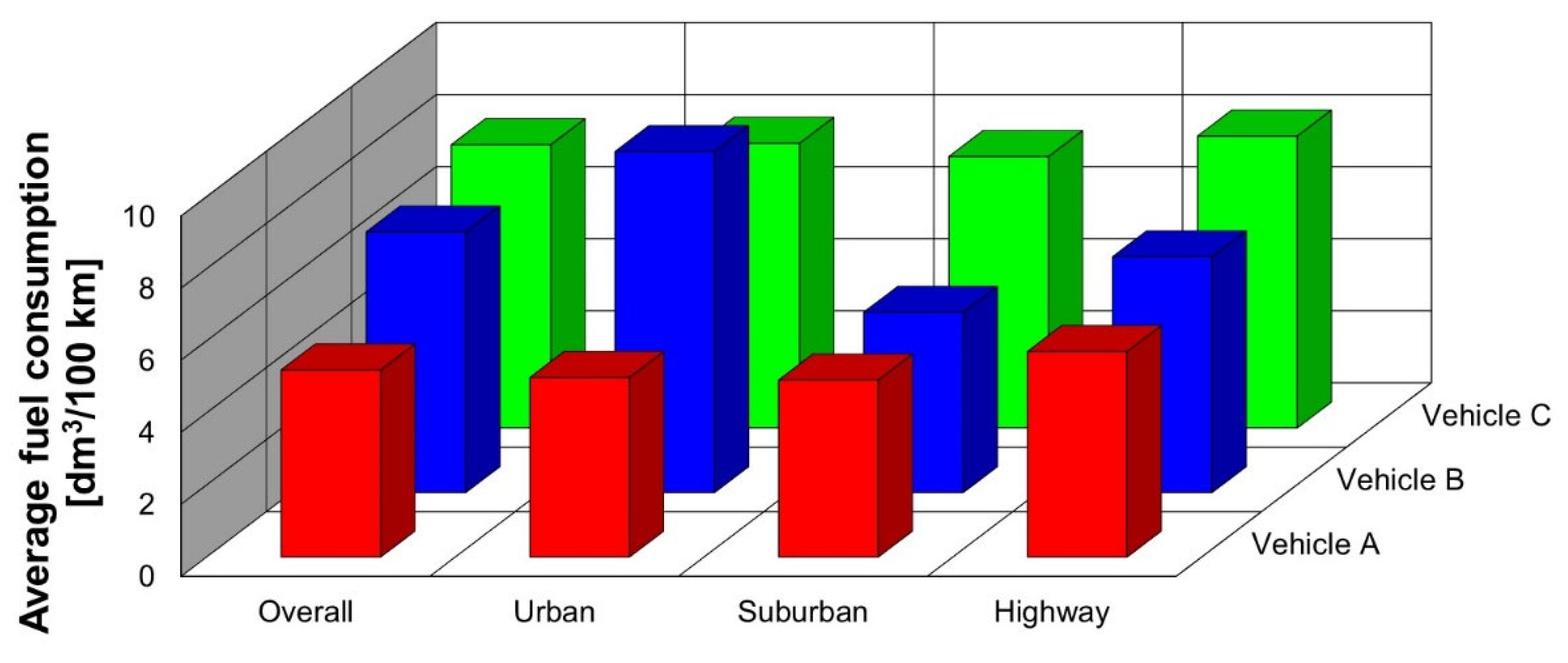

| Parameter | Measurement Method | Measurement Range | Measurement Accuracy |
|---|---|---|---|
| THC | Flame ionization | 0–10,000 ppm | ±2.5% |
| NOx | Non-dispersive ultraviolet | 0–3000 ppm | ±3% |
| CO | Non-dispersive infrared | 0–10% | ±3% |
| CO2 | Non-dispersive infrared | 0–20% | ±3% |
| O2 | Electrochemical | 0–20% | ±1% |
| Exhaust gas flow | Mass flow Tmax up to 700 °C | ±2.5% ±1% |
| Vehicle A | Vehicle B | Vehicle C | |
|---|---|---|---|
| Ignition | Spark ignition | Compression ignition | Spark ignition |
| Displacement | 1.6 dm3 | 2.2 dm3 | 0.7 dm3 |
| Number and arrangement of cylinders | 4 in-line | 4 in-line | 2 in-line |
| Maximum power output of combustion engine | 80 kW | 150 kW | 28 kW |
| Maximum power output of electric engine | 32 kW | ------ | 125 kW |
| Unit power output index | 0.55 kW/kg | 0.53 kW/kg | 0.08 kW/kg |
| Injection system | GDI | Common Rail | MPI |
| Aftertreatment | TWC | EGR, DPF, DOC, SCR | TWC |
| Transmission | Automatic | Automatic | Automatic |
| External dimensions length/width/height | 4.47/1.82/1.45 m | 4.82/1.94/1.80 m | 4.00/1.78/1.58 m |
| Total weight | 1870 kg | 2950 kg | 1620 kg |
| No. | Parameters | Units | Value Vehicle A | Value Vehicle B | Value Vehicle C |
|---|---|---|---|---|---|
| 1. | Total distance | km (-) | 82.6 | 70.41 | 80.56 |
| 2. | Total time | min. (90–120) | 117 | 113 | 106 |
| 3. | Cold-start duration | min. (5) | 5 | 5 | 5 |
| 4. | Urban distance | km (>16) | 32.4 | 29.41 | 35.31 |
| 5. | Rural distance | km (>16) | 24.49 | 18.71 | 22.32 |
| 6. | Highway distance | km (>16) | 25.71 | 22.28 | 22.93 |
| 7. | Share of urban distance | % (29–44) | 39.23 | 41.77 | 43.83 |
| 8. | Share of rural distance | % (23–43) | 29.64 | 26.58 | 27.71 |
| 9. | Share of highway distance | % (23–43) | 31.13 | 31.65 | 28.47 |
| 10. | Average speed in the urban cycle | km/h (15–40) | 23.40 | 20.65 | 27.61 |
| 11. | Speed in the highway cycle exceeding 145 km/h | km/h (<3%) | 0 | 0 | 0 |
| 12. | Speed in the highway cycle exceeding 100 km/h | Min. (>5) | 9.70 | 8.88 | 10.88 |
| 13. | Stationary time in the urban cycle | 5% (6–30) | 28.57 | 29.67 | 25.65 |
| 14. | Start and end points, absolute elevation difference | M (<100 m) | 3.4 | 19 | 7.6 |
| 15. | Accumulated positive elevation increment | m/100 km (<1200 m/100 km) | 454.36 | 581.12 | 623.90 |
| Vehicle A | Vehicle B | Vehicle C | |
|---|---|---|---|
| Total | 123.01 g/km | 194.72 g/km | 174.09 g/km |
| Urban portion | 118.17 g/km | 254.77 g/km | 187.37 g/km |
| Rural portion | 116.52 g/km | 134.63 g/km | 174.95 g/km |
| Highway portion | 134.86 g/km | 176.27 g/km | 152.81 g/km |
Disclaimer/Publisher’s Note: The statements, opinions and data contained in all publications are solely those of the individual author(s) and contributor(s) and not of MDPI and/or the editor(s). MDPI and/or the editor(s) disclaim responsibility for any injury to people or property resulting from any ideas, methods, instructions or products referred to in the content. |
© 2023 by the authors. Licensee MDPI, Basel, Switzerland. This article is an open access article distributed under the terms and conditions of the Creative Commons Attribution (CC BY) license (https://creativecommons.org/licenses/by/4.0/).
Share and Cite
Ziółkowski, A.; Fuć, P.; Jagielski, A.; Bednarek, M.; Konieczka, S. Comparison of the Energy Consumption and Exhaust Emissions between Hybrid and Conventional Vehicles, as Well as Electric Vehicles Fitted with a Range Extender. Energies 2023, 16, 4669. https://doi.org/10.3390/en16124669
Ziółkowski A, Fuć P, Jagielski A, Bednarek M, Konieczka S. Comparison of the Energy Consumption and Exhaust Emissions between Hybrid and Conventional Vehicles, as Well as Electric Vehicles Fitted with a Range Extender. Energies. 2023; 16(12):4669. https://doi.org/10.3390/en16124669
Chicago/Turabian StyleZiółkowski, Andrzej, Paweł Fuć, Aleks Jagielski, Maciej Bednarek, and Szymon Konieczka. 2023. "Comparison of the Energy Consumption and Exhaust Emissions between Hybrid and Conventional Vehicles, as Well as Electric Vehicles Fitted with a Range Extender" Energies 16, no. 12: 4669. https://doi.org/10.3390/en16124669
APA StyleZiółkowski, A., Fuć, P., Jagielski, A., Bednarek, M., & Konieczka, S. (2023). Comparison of the Energy Consumption and Exhaust Emissions between Hybrid and Conventional Vehicles, as Well as Electric Vehicles Fitted with a Range Extender. Energies, 16(12), 4669. https://doi.org/10.3390/en16124669









